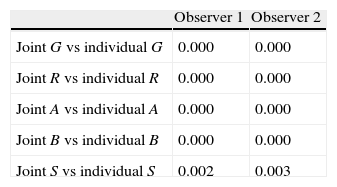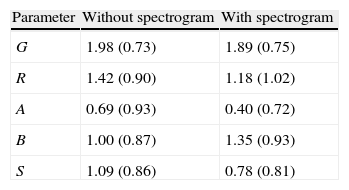Perceptual evaluation of voice quality remains a key standard for judgement of vocal impairment. The GRABS method has become a commonly used scale for rating severity of dysphonia, but it has no published, standardised protocol to follow. Training is important for reaching good interrater agreement for its parameters; however, the references most often cited for the GRABS provide no guidelines for clinical administration, speech material or rating calibration. This study investigated the effect of anchors (standard reference voices) and visible speech (narrow band spectrogram) in training non-expert professionals in the GRABS method.
Material and methodsFour inexperienced listeners evaluated 107 recorded pathological voices using the GRABS scale in 2 separate sessions; at first, without a visible spectrogram and then, 6 months later, with anchors and a narrow band spectrogram as additional information.
ResultsThe results show that anchors and visible speech helped to improve the reliability of G, B, A and S parameters. Interrater agreement according to k statistics was significantly stronger with the addition of spectrographic information for rating breathiness and strain.
DiscussionThis study found that non-expert listeners showed significant improvement after training with external anchors (standard reference voices) and a narrow band spectrogram.
La evaluación perceptual de la calidad vocal sigue siendo un importante método para evaluar los trastornos vocales. El método GRABS se ha consolidado como una escala frecuentemente utilizada para puntuar la severidad de una disfonía, pero no se ha publicado un protocolo estándar para guiarse. El entrenamiento es importante para alcanzar una buena concordancia en la calificación de sus parámetros entre distintos observadores, sin embargo, las referencias bibliográficas más citadas no describen orientaciones para su uso clínico, muestras a analizar o calibración.
Material y métodoEste estudio investigó el efecto de voces patrón y la espectrografía de banda estrecha en el entrenamiento del GRABS de profesionales no expertos. Las voces de 107 pacientes fueron evaluadas por 4 profesionales no expertos utilizando la escala GRABS en 2 sesiones, primero sin voces patrón ni espectrograma y 6 meses después con voces patrón y espectrograma de banda estrecha.
ResultadosLos resultados muestran que las voces patrón y el espectrograma ayudaron a mejorar la fiabilidad de los parámetros G, B, A y S. La concordancia entre los distintos observadores de acuerdo al estadístico k fue significativamente mayor con la adición de la información espectrográfica para los parámetros B y S.
DiscusiónEste estudio demuestra que los profesionales no expertos mejoran significativamente sus puntuaciones tras el entrenamiento con voces patrón y la visualización del espectrograma de banda estrecha.











